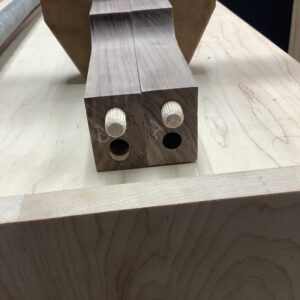I have a project joining face grain to end butt, doweled with one dowel about 1 1/2” total width. Worried that might not be enough or joint could separate. Is it OK , or should I be concerned?
Discussion Forum
Get It All!
UNLIMITED Membership is like taking a master class in woodworking for less than $10 a month.
Start Your Free TrialCategories
Discussion Forum
Digital Plans Library
Member exclusive! – Plans for everyone – from beginners to experts – right at your fingertips.
Highlights
-
Shape Your Skills
when you sign up for our emails
This site is protected by reCAPTCHA and the Google Privacy Policy and Terms of Service apply. -
 Shop Talk Live Podcast
Shop Talk Live Podcast -
 Our favorite articles and videos
Our favorite articles and videos -
E-Learning Courses from Fine Woodworking
-
-
 Fine Woodworking New England Event
Fine Woodworking New England Event -














Replies
What's the application?
What kind of force will it be subjected to?
I've repaired a lot of furniture that had dowel joints fail. I would just never, ever use them.
I'd use a mortise and tenon if I wanted the joint invisible. A bridle joint if it didn't matter.
Agree with JC2... just not enough. Step up to a floating M&T at minimum. I would also connect those twin dowel holes to turn the into floating tenon pockets. Actually, drilling for dowels is not a bad way to set the edges of the pockets on both sides of the joint.
I agree, I've repaired my share of furniture with failed dowels. Maybe b/c they didn't use enough glue.
A also agree if you have a router, but no mortiser, a floating tenon would be a good option.
Holer hard there...
A lot of antique furniture, particularly at the lower end of the quality spectrum was made with twin dowels and has survived well. It's not as strong as an M&T joint, but a dowel can be a strong joint.
Most modern low cost furniture is doweled too.
It really depends on the application - if the item is to see light occasional use, or is not likely to be subject to much in the way of racking forces (say an occasional table) then it will be fine. If it is a chair that will see daily use, then it will have a limited lifespan with that joinery, but it will still work.
A floating tenon has a few advantages over dowels - it will provide a much larger glue surface area, it will not change shape in a meaningful way due to humidity changes and being longer, it will provide much more mechanical support to the joint, essentially removing the need for the butt joint glue at all - it is in fact sufficient to glue the tenon cheeks only. (Yes, we have all seen THAT video, but seriously, how many of you could pull a decent M&T joint apart when it's glued?)
So depending on use, it may be fine - artwork certainly, child's toy - probably, table - it will last a long time, chair - not so much.
It looks like you've already committed to the single dowel, so I'll make a suggestion. Use a longer dowel -make the mating hole deeper in the face grain piece. The long grain to dowel glue joint will be plenty strong (long grain to long grain); it's the face grain side that should concern you the most.
And keep this in mind - since a dowel is technically a tenon - that the length will have a greater effect on strength than width. And because you have a dowel, it should be easy to make it longer.
And for the record - a dowel joint IS technically a mortise and (floating) tenon joint w/ the tenon width equal to the tenon thickness.
Indeed, but dowels are circular, which does cause a fault that is not seen with a square peg - expansion and contraction of the dowel causes tension on the glue at almost all points around the dowel. Based on an FWW article, this seems to be the primary mode of dowel joint failure.
The shape of a square peg mitigates against this failure as the filled-in corners provide markedly more glue surface both resisting contraction and providing additional support. The total glue surface area is 21.5% more for a square peg of equivalent size.
So yes, the dowel is a loose tenon, but the specific shape of that tenon is important to the lifespan of the joint, if not in practical terms to its initial strength.
Thank You to all responses, the info is very useful. I will probably change the dowel joints to a floating tenon. I just don’t want the joint to separate and become wobbly, down the road in a numbers of years. The piece is a mid-century credenza, which my wife will store lighter weight stuff in. Got the idea from FW, and help from Libby Schaum, who designed the piece, and her woodworking school. She was extremely helpful, and I really do appreciate her help. Again, Thank You everyone for you sharing your knowledge.
Oh and the piece was originally designed with Domino joints, which of course I don’t have/afford, so I thought dowels would be a good option.
“[Deleted]”
I just got an old rocking chair to "fix" for neighbor, 1914 was written on the underside. Some parts had dowels that are very loose. Chairs take a real beating so they are at the extreme for strength requirements so take that into consideration. I only use dowels where joints are under compression with very little lateral stress.
This forum post is now archived. Commenting has been disabled